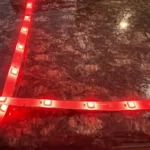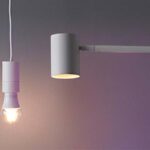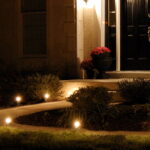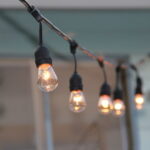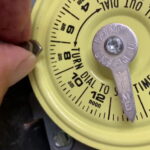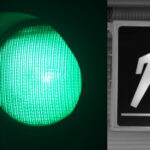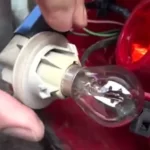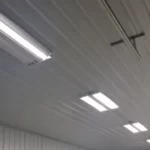Do Outdoor Lights Need To Be On Their Own Circuit? All You Want To Know
Whether you’re rewiring your home and want to make sure your existing outdoor lights are connected properly, or you’re planning to add new outdoor lighting to your house, it’s important to think about whether they require their own circuit.
Outdoor lighting is frequently an afterthought.
It’s common to see them wired into an existing circuit for indoor lighting because they are installed after all the major electrical work has been completed. But is that OK?
Do outdoor lights need to be on their own circuit? Outdoor lighting should ideally be on a separate circuit so that if something goes wrong, it won’t also trip the indoor lighting. They do not need to be on a separate circuit, but you must properly insulate the circuit to keep the outside elements out.
Please continue reading for more information.
Table of Contents
What Circuit Should Outdoor Lights Be On?
When wiring any type of lighting (or anything electrical), there are two basic circuit types that you can use: series and parallel.
If you opt for a series circuit, each light is connected “in series” with the one before it, creating one continuous loop in the circuit. Each light is on its own loop in a parallel circuit.
There are a few factors to take into account when installing garden lighting, but the most important one is how complex your circuit must be.
Consider a scenario in which you are only mounting a few wall lights.
In that situation, wiring a parallel circuit may be easier for you or your electrician. However, you must consider how to wire in parallel for stake or string lights without destroying your entire garden or decking.
When possible, parallel circuits are always preferable because any malfunctions will only affect the portion of the loop they are on.
You won’t have to go without light until you’ve fixed or replaced the problem if one bulb fails because the other bulbs will still function.
When one bulb in a series burns out, the others in the series also stop working, which makes it more difficult to pinpoint the issue.
But it’s difficult to wire in parallel outside. You are protected from the elements and other disruptive factors indoors by your home’s natural defenses.
To ensure the safety of all wires outside, check them all. That entails complete waterproofing as well as defense against animal and plant roots.
If you’re simply adding outdoor lighting without undertaking major renovations, a series circuit might make more sense.
However, it’s important to plan your lighting circuits as soon as possible if you’re adding outdoor lights as part of a larger garden renovation, as is frequently the case. This will allow you to safely insulate and bury them as necessary.
Your outdoor lights should be on a 5-amp circuit in terms of amperage. 13 amps is way too much and won’t be sustainable on the wiring you’ll use, but 3 amps may limit your lighting options.
Which Cable Is Appropriate For Outdoor Lighting?
Compared to indoor lighting, your outdoor lighting circuit is much more vulnerable to threats. Think about it:
- How often does it rain inside?
- How many wild animals are running around inside your walls, possibly nibbling your wiring?
- How many plants are expanding their roots throughout your interior wiring?
I’m hoping that all of the above questions have a zero answer.
Additionally, you must consider your own slip-ups. While it is possible, if you are not careful, to hammer a nail into a wire indoors, it is uncommon.
But how often might you be using a shovel or cutting the grass next to an outdoor cable?
It’s a lot to think about, then. This is why you must carefully consider how to protect your wiring when setting up outdoor lighting.
Use of SWA cabling is therefore recommended. You can guess why you should use it by knowing that SWA stands for steel-wire-armored.
Rubber is used as insulation instead of PVC. PVC-sheathed cable may be watertight, but it will become weakened from sun exposure and may even crack.
Animals that may try to eat through the rubber in vulnerable areas could be deterred by the steel armoring.
Even steel-armored cable can be cut by shovels or lawn mowers, so you’ll still need to bury the cable.
1.5mm cabling is usually the right thickness to carry enough load for outdoor lights. It will be safe to use and secure enough.
When burying cables under driveways or paths, try to dig them at least 450mm (about 1.5 feet) or 750mm (about 2.5 feet) into the ground, or deeper if they are in a potentially excavatable area.
To serve as a warning, you should also place electrical route marker tape at a depth of approximately 150mm (0.5 feet).
What Time Of Year Is Best For Landscape Lighting Installation?
Can An Outdoor Light Be Wired To An Indoor Switch?
You’ll also need to think about how to control your outdoor lighting.
To make sure that the outdoor lighting turns on when necessary, many people install motion detectors or ambient light detectors.
But most of the time, you’ll want some type of manual control, so a switch will be required.
Therefore, you will be able to connect an outdoor light to an indoor switch, giving you control over the lights.
Having said that, there are some crucial factors to take into account, this time regarding the secure installation of your lighting circuit.
If you’ve wired your entire outdoor lighting circuit as a standalone unit and are only using an indoor switch, there won’t be any issues.
As long as you’ve made sure it’s secure by heeding all of the above advice.
But let’s say you don’t have the outdoor elements completely sealed and you’re wiring your outdoor lights on any indoor circuit.
In that case, you’re taking a risk because inclement weather could easily bring moisture into your indoor circuit and create a significant hazard.
Are Gfci-protected Outdoor Outlets Required?
The National Electrical Code specifies a number of requirements that outlets must adhere to in order to ensure public safety and avoid problems caused by subpar and faulty wiring. Your outdoor outlets are no different because the NEC also specifies specific requirements for them.
The GFCI standard is one of the requirements set forth by law for outdoor outlets. GFCIs are specifically required by law for outdoor outlets for a number of reasons, so you are correct. But first, let’s define GFCI.
It’s important to realize that due to the frequent exposure to outdoor elements, your outdoor outlets and any other electrically-based outdoor structures must be weatherproof. They must be resilient to rain and severe weather. In other words, you should never mix water and electricity.
Your outdoor outlets must be GFCI-equipped in this regard. GFCI stands for ground fault circuit interrupter. But how does that operate?
Your electrical outlets’ wires can no longer contain the electricity that flows through them if they become wet or if something else happens to them, like when the wires deteriorate or break. The electricity will then start to flow toward the ground, resulting in a sudden electrical surge known as a ground fault. The ground fault can then shock people, kill them, or inflict severe injuries on them.
As a result, now that you are aware of the potential damage a ground fault can cause, you should be aware that your outdoor outlets require GFCI protection due to the fact that they are constantly exposed to weather elements such as rain and other factors that could result in a ground fault.
A GFCI outlet is built to detect sudden changes and variations in the current flowing through it, so that whenever there is a problem with the current, it will immediately shut down any connected appliances to prevent harm or damage. A GFCI outlet has its own internal switch that will instantly activate whenever there is a problem with the electrical current, despite the fact that it functions similarly to a circuit breaker.
A GFCI outlet’s role, in a sense, is to cut off the power when a sudden electrical surge is detected to ensure that nothing untoward results from that faulty electrical current. For this reason, all of your outdoor outlets and any other outlets near a water source, such as those in your bathroom, kitchen, and laundry room, need to be GFCIs.
The Height At Which Outdoor Electrical Outlets Should Be Installed
In addition to mandating that your outdoor electrical outlets be GFCI, the NEC also imposes a height.
There is no legal minimum for how high your electrical outdoor outlets should be, though. If you want, you can have them as close to the ground as you can. You should be aware that your outdoor outlets have a maximum height. In actuality, they must be placed no higher than 6 ½ feet off the ground.
This means that you can place your outdoor outlets at any height above the ground as long as it is less than 6 ½ feet.

Is Conduit Required For Outdoor Electrical Wires?
The same NEC also set certain rules for outdoor electrical wires and conduits:
- The application of exposed or buried wires must be listed.
- UF cables must be directly buried at a minimum of 24 inches below the ground’s surface when being used as buried cables.
- The ground must be buried at least half a foot beneath any wires that are buried inside a rigid metal conduit or an intermediate metal conduit. In the meantime, PVC conduit wiring needs to be buried 1.5 feet below the surface.
- A smooth and granular material must be used for any backfill that is placed around the conduit or cables. Rocks shouldn’t be present in this substance.
- Low-voltage buried wiring needs to be buried at least six inches underground.
- From the required depth of 18 inches to its point of termination above the ground, any wiring that is buried and transitions from underground to above the ground must be protected in conduit.
- All electrical service wires that are hanging over an outdoor body of water, like a hot tub or pool, must be at least 22 feet above the platform for diving, if one is present.
- All telephone and internet data transmission cables must be at least 10 feet above the water’s surface where hot tubs and pools are located.
See more about
Should Outlets And Lights Be On Separate Circuits?
Whether or not outdoor lights and outlets should be on separate circuits is up for debate, but the NEC only stipulates that the aforementioned is required of them. In that sense, the fact that they must be GFCIs eliminates the need for them to be in separate circuits.
If you prefer, you can still put your outdoor outlets and lights on separate circuits. Perhaps you don’t want the circuit to overload is one of the justifications for doing this. When multiple power tools are used on various outdoor outlets that are all connected to the same circuit, that is a good illustration. Due to the amount of power these tools require, this may overload the circuit.
In light of this, even though the law does not specify whether or not outdoor lights and outlets must be on separate circuits, you may still choose to do so for safety reasons or if you feel the need to. You may ask an electrician’s opinion to get a second opinion on the matter, but it is entirely up to you.
Are Gfci-protected Outdoor Outlets Required?
The National Electrical Code specifies a number of requirements that outlets must adhere to in order to ensure public safety and avoid problems caused by subpar and faulty wiring. Your outdoor outlets are no different because the NEC also specifies their own unique requirements.
The law stipulates that outdoor outlets must be GFCI-protected as one of its requirements. Yes, for several reasons, the law specifically stipulates that outdoor outlets must be GFCI-compliant. What does GFCI mean, though, before we continue?
You must be aware that due to the frequent exposure to outdoor elements, your outdoor outlets and any other electrically-based outdoor structures must be weatherproof. They must be resilient to rain and severe weather. Simply put, it’s never a good idea to combine water and electricity.
In that regard, GFCI, or ground fault circuit interrupter, outlets are required for outdoor outlets. But how does this operate?
Your electrical outlets’ wires can no longer contain the electricity that flows through them if they become wet or if something else happens to them, like when the wires deteriorate or break. A sudden electrical surge known as a ground fault will then occur as a result of the electricity starting to flow to the ground. Anybody in the path of the ground fault may then be shocked, die, or sustain injuries.
Now that you know what a ground fault can do, you should be aware that your outdoor outlets must be GFCI due to the fact that they are constantly exposed to the rain and other outdoor conditions that could result in a ground fault.
A GFCI outlet is built to be able to detect sudden changes and variations in the current that flows through it, so that whenever there is a problem with the current, it will immediately shut down any appliances that are connected to it to prevent any harm or damage. A GFCI outlet has its own internal switch that will instantly activate whenever there is a problem with the electrical current, despite the fact that it functions similarly to a circuit breaker.
In a sense, the function of a GFCI outlet is to cut off the power when a sudden electrical surge is detected in order to ensure that nothing untoward happens as a result of that faulty electrical current. Your outdoor outlets and every other outlet near a water source, including those in the bathroom, kitchen, and laundry room, must be GFCI protected for this reason.
How Far Off The Ground Should Outdoor Electrical Outlets Be?
The NEC imposes a height in addition to requiring GFCIs in all outdoor electrical outlets.
However, there is no legal minimum for how high above the ground your electrical outdoor outlets must be. If you want, they can be as close to the ground as possible. However, you need to be aware that your outdoor outlets have a maximum height. In fact, they must be placed no higher than 6 ½ feet off the ground.
This means that you are free to place your outdoor outlets at any height above the ground as long as it doesn’t exceed 6 ½ feet.
Does Conduit Have To Be Used For Outdoor Electrical Wires?
The same NEC also set certain rules for outdoor electrical wires and conduits:
- It is necessary to list wires for their application, whether they are buried or exposed.
- It is necessary to directly bury UF cables as buried cables at least 24 inches below the ground’s surface.
- The ground must be buried at least half a foot beneath any wires that are buried inside a rigid metal conduit or an intermediate metal conduit. The PVC conduit for wiring must be buried 1.5 feet below the surface.
- A smooth and granular material must be used for any backfill that is placed around the conduit or cables. There shouldn’t be any rocks in this stuff.
- Low-voltage underground wiring needs to be buried at least 6 inches deep.
- From the required depth of 18 inches to its point of termination above the ground, any wiring that is buried and transitions from underground to above the ground must be protected in conduit.
- All electrical service wires must be at least 22 ½ feet above the surface of any outdoor body of water, including a pool or hot tub, or the diving platform (if one is present).
- In order to avoid interference with other nearby bodies of water, including swimming pools and hot tubs, all data transmission wires for your phone or internet must be at least 10 feet above the water’s surface.
Should Outlets And Lights Be On Separate Circuits?
Whether or not outdoor lights and outlets need to be on separate circuits, the NEC does not stipulate that they should be, as only the aforementioned are necessary. In that regard, the fact that they must be GFCI-compliant suffices, so they are not required to be in separate circuits.
Your outdoor outlets and lights can still be on separate circuits, if that’s what you prefer. You might not want the circuit to overload, so that is one of the justifications for doing this. A good illustration of that is when someone uses multiple power tools on various outdoor outlets that are all connected to the same circuit. Because of how much power these tools need, this could overload the circuit.
In light of this, even though the law does not specify whether or not outdoor lights and outlets must be on separate circuits, you may still choose to do so for safety reasons or if you feel the need to. Although you can get a second opinion by consulting an electrician, the decision is entirely up to you.
FAQs
Which Outdoor Lighting Options Are Best For Gardens?
In general, you’ll want to make sure your garden’s lights are waterproof. It might be worth looking into solar-powered outdoor lights with independent action in order to avoid running wires to the far corners of the garden. You won’t need lights with particularly high brightness if you’re looking for general ambient lighting to fill the garden rather than intense lighting on a single subject, but you may need a lot of lights to cover a larger surface area.
How Tall Should A Mounting Be For An Outdoor Light?
Measured from the center of the fixture, outdoor sconces must be 66 inches tall. They should be 7 feet high if you are mounting lights on posts. An excellent general rule of thumb is to add one-fourth of the feature’s height to the top when placing lights above doorways or windows.
How Far Should Exterior Lights Be Spaced?
Depending on the brightness, the distance between exterior lights should be about 6 feet. You should place them roughly three feet apart because some applications, like stairwells, may call for more constant lighting.
Once the foundations of outdoor lighting placement are understood, you can move on to the fun stuff, such as using smart lights to create moods, enhance the environment, and sync with music.
The Bottom Line
It is extremely convenient to have access to electricity even when you are outside. With the aid of outdoor outlets, you can provide power to your backyard and other outdoor areas. There are a few requirements that you must fulfill that were outlined in this article before you can install this kind of outlet.
When installing outlets, extra care should be taken because they are a source of electricity. Additionally, it’s crucial to confirm that the outlets you’ll be installing adhere to NEC standards. You will be protected from potential electrical surges and your outlets will be made safe to use.
Thank you for reading.




![9 Best Boat Dock Lighting Ideas In 2022 [Updated]](https://www.totallylight.com/wp-content/uploads/2022/09/9-Best-Boat-Dock-Lighting-Ideas-In-2022-Updated-150x150.jpg)


